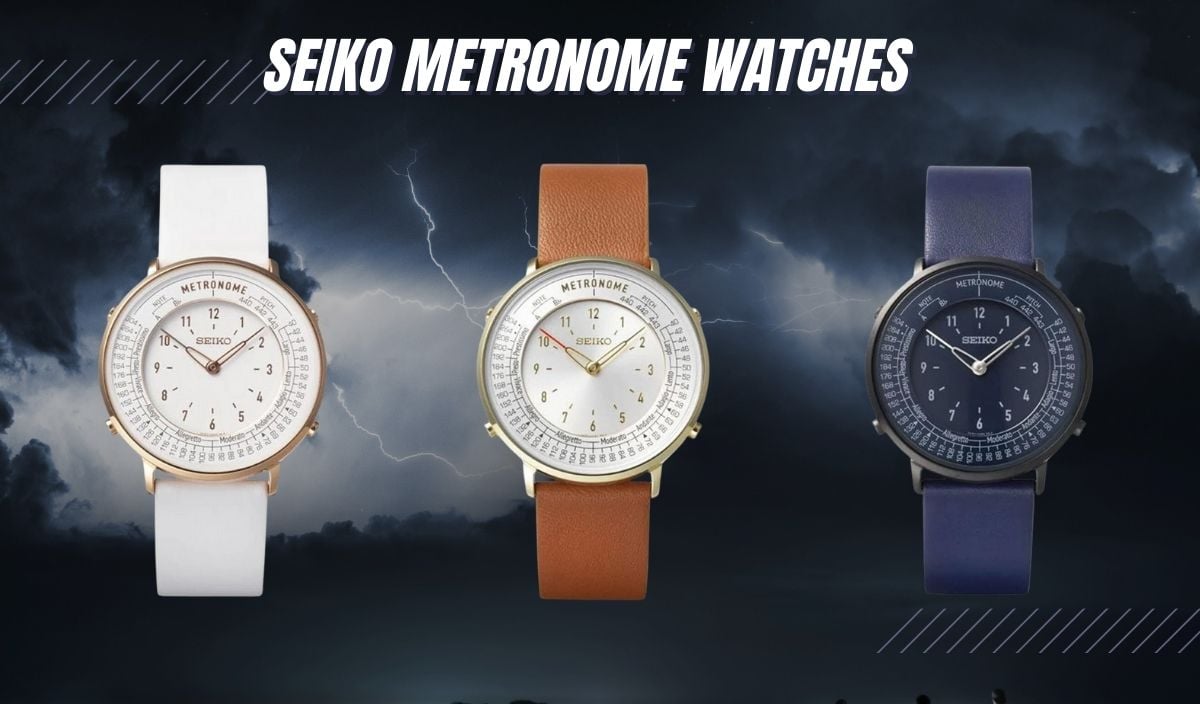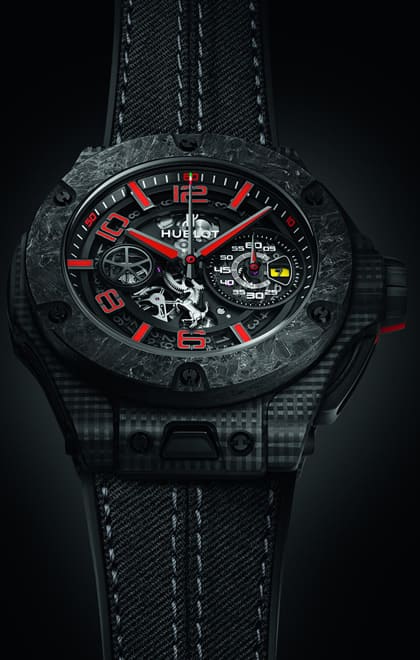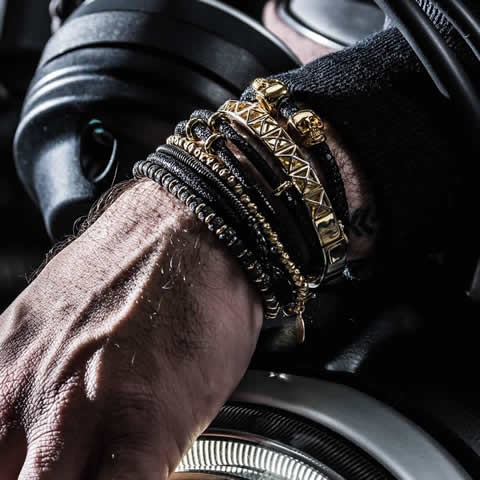
Seiko Metronome Watches: Everything You Need To Know
Metronomes are an essential tool for musicians. Playing in time is one of the fundamental skills necessary to be successful in performing almost any style of music, let alone getting called to perform with others.
To practice this, musicians often rely on metronomes to provide a steady pulse to practice to, and illuminate their mistakes. Because of this, metronomes are sometimes referred to as one of the great equalizers in the field of music.
Metronomes function by making a noise at a steady rate, which is set by the user. For example, if practicing a piece performed at 140 bpm (beats per minute), the user would set their metronome to that pace and attempt to perform the passage at that pace. Depending on what needs to be addressed and the user’s goal, they may slow or speed up the metronome.
Conventional metronomes you may have seen on a relative’s piano required a mainspring to be wound, and a counterweight would be used to adjust the tempo. More modern ones are digital devices that are pocket-sized and easily fit in instrument cases. With that, there are great apps for smartphones today that are powerful metronomes with extensive tools that aid musicians in their practice routines.
For watch enthusiasts, there are some overlaps between watches and metronome devices. Patek Philippe made a metronome pocket watch around 1880. Cadenzia Palmer also made one that was much more mass-market, and examples can still be found today. However, to the best of my knowledge and research, there has not been an analog display wrist-worn metronome watch until the Seiko Metronome watches released in 2022.
About Seiko Metronome Watches
Seiko Watch Company actually does not produce these watches. Seiko Instruments is responsible for the manufacturing of the Seiko Metronome watches, along with a myriad of technology products. Seiko Instruments has a long history of making metronomes, including conventional mechanical metronomes.
For the watchmaking component, one may think that Seiko Instruments may be out of bounds making a watch and that they may rely on Seiko Timepieces for that portion. While there probably is some overlap, Seiko Instruments makes clocks in various sizes and with numerous functions, meaning there is plenty of know-how within Seiko Instruments to pull off this impressive watch.
The Seiko Metronome watches are obviously a unique proposition in the watch world, given the quirky set of complications. For musicians, they propose a handy set of tools to be worn on the wrist. Punctuality for rehearsals and concert call times is essential.
A metronome, as already described, is a valuable practice tool. Given its ability to mark tempos from 40 bpm to 304 bpm, it allows for a wide variety of practice speeds, in addition to noting smaller note values at slower tempos.
For example, you could set the metronome at 240 bpm to mark eight notes and 120 bpm. There is also a tuning pitch function, sounding an audible pitch that can be set to A or Bb. You can also adjust the pitch of the A to 440 Hz, 442 Hz, or 443 Hz.
In-Depth Guide to Seiko Metronome Watches
To cover the more conventional aspects of the Seiko Metronome watches, here are the technical aspects of these unique timepieces.
Case Dimensions
The Seiko Metronome watches measure 36.5mm wide, 39mm lug-to-lug, 10mm thick, and have 18mm lugs. The compact dimensions make them suitable for a wide audience and a number of situations.
With the design being mostly the dial, it will fill space on the wrist more so than the case dimensions may suggest. The case is rated for daily-use water resistance, which means it can only handle daily hand washing and being caught in a rain storm while on the wrist.
Model Variations
There are two main dial designs split between two lines: the standard line and the casual line. The standard line has more markings for the metronome, offering more accurate measurements of tempos. The casual line has more colorful dials and fewer metronome markings. Below are the various models separated by product lines.
Standard Line
SMW002A: White dial, rose gold case, white strap
SMW005A: Turquoise dial, gold case, beige strap
SMW006A: White dial, steel case, black strap
SMW003A: Silver dial, gold case, brown strap
SMW004A: Blue dial, black case, blue strap
SMW001A: Black dial, gold case, brown strap
Casual Line
SMW004B: White and blue dial, steel case, blue strap
SMW001B: White and black dial, steel case, black strap
SMW002B: Pink and white dial, gold case, white strap
SMW003B: Purple and white dial, gold case, white strap
All of the various models come with calf leather straps. There are also special editions with different straps to change the overall look and formality of the watch.
Operation
With the various functions of this watch, it is likely best to look at the owner’s manual to fully understand how to utilize the watch. That being said, here is a brief overview of how to operate the various functions. The pusher at the lower left side of the watch (8 o’clock) is the function button.
Each press cycles between the different functions. Assuming one is starting in the time-telling mode, a single press puts the watch into metronome mode. Both hands will move to 12 o’clock, and the minute hand will start oscillating back and forth to indicate the desired tempo.
The hour hand will move to the indicated tempo. The upper left pusher (10 o’clock) controls the audible click for the metronome, and the pushers on the right-hand side of the case (2 o’clock and 4 o’clock) control the tempo.
The next mode is the pitch mode, with the two pushers on the right-hand side of the case used to cycle through the different pitches.
To set the time, a long press on the 10 o’clock pusher starts the time setting mode, with the two pushers on the right side of the case used to adjust the time. Another press of the 10 o’clock pusher sets the time, and the watch will begin to run.
Movement
Inside the Seiko Metronome watch is the quartz caliber PA50, which runs on a standard CR 2016 battery that is rated for 2 years. The movement is rated to an accuracy of +/- 15 seconds a month.
On the Seiko Instrument Japan website, there is a brief explanation of the two specially designed motors for the hands, allowing them to move in both directions for the metronome functions. It is clear that some clever engineering was involved in creating this watch.
Seiko Metronome Watches Pricing & Availability
Even though the Seiko Metronome Watches have proven popular amongst watch enthusiasts, their availability is limited to the Japanese market. Platforms such as eBay will facilitate global powers being in touch with Japanese dealers, but these platforms may charge a premium above the 26,400 JPY retail price (about 180 USD at the time of writing).
In addition to the limited market availability, they seem to sell out quite quickly, but with the promise of more being available. With patience, securing a Seiko Metronome Watch should not be too difficult.
Should You Buy a Seiko Metronome Watch?
As with almost any watch, if it is affordable and interesting, there is no reason why someone should not buy one! With its fun design and complications, it will likely provide some levity to one’s watch collection.
For musicians who are also watch enthusiasts, a Seiko Metronome Watch will probably be a frequently worn and used watch in their collection. While apps may be more immediately useful, watch enthusiasts know that there is something charming about a more analog wrist-worn experience.
Conclusion
It is always exciting when a watch company releases a unique product, and Seiko Instruments definitely did so here. While its intended use is only immediately practical to a relatively small audience, watch enthusiasts, in general, will likely enjoy interacting with the metronome function.
Seiko Instruments did a great job of designing an attractive watch while incorporating the indications needed for the metronome and tuner functions. If one is willing to do the extra leg work of locating one, the affordable price makes them attainable to a wide audience.
About Exquisite Timepieces
Established in 1998, Exquisite Timepieces is your one-stop shop for all things luxury watches! We are an authorized dealer for 60+ luxury watch brands including Omega, Hublot, Seiko, & Longines! We are proud to showcase one of the world’s largest pre-owned watch collections, including renowned brands like Rolex and Patek Philippe. Check out our brand new watch arrivals here and popular pre-owned listings here.








